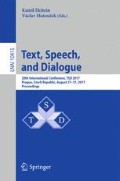Abstract
Inspired by the great potential of linguistic features in preserving and revealing writers’ state of mind and conception in certain space and time, we use linguistic features as a vehicle to extract pieces of significant information from a large set of text of known origin so as to construct a context for personal inspection on the writer(s). In this research, we choose a set of linguistic features, each of a grammatical function or a grammatical association pattern, and each represents a different perspective of contextual annotation. In particular, the selected grammatical items include personal pronoun, negation, noun chunk, and are used as text slicing tubes for extracting a certain aspect of information. The initial results show that some selected grammatical constructions are effective in extracting descriptive evidence for construing historical context. Our study has contributed to exploring an effective avenue for innovative history studies by means of examining linguistic evidence.
Access this chapter
Tax calculation will be finalised at checkout
Purchases are for personal use only
References
Biber, D., Reppen, R.: Corpus Linguistics. Sage, London (2012)
Brewer, M.B., Gardner, W.: Who is this “we”? Levels of collective identity and self representations. J. Pers. Soc. Psychol. 71(1), 83 (1996)
Burrows, J.: ‘Delta’: a measure of stylistic difference and a guide to likely authorship. Literary Linguist. Comput. 17(3), 267–287 (2002)
Chaski, C.E.: Who’s at the keyboard? Authorship attribution in digital evidence investigations. Int. J. Digit. Evid. 4(1), 1–13 (2005)
Eggins, S.: Introduction to Systemic Functional Linguistics. A&C Black, London (2004)
Halliday, M., Matthiessen, C.M., Matthiessen, C.: An Introduction to Functional Grammar. Routledge, London (2014)
Hoover, D.L.: Frequent word sequences and statistical stylistics. Literary Linguist. Comput. 17(2), 157–180 (2002)
Hu, X., Wang, Y., Wu, Q.: Multiple authors detection: a quantitative analysis of dream of the red chamber. Adv. Adapt. Data Anal. 6(04), 1450012 (2014)
Íñigo-Mora, I.: On the use of the personal pronoun we in communities. J. Lang. Polit. 3(1), 27–52 (2004)
Koppel, M., Schler, J., Argamon, S.: Computational methods in authorship attribution. J. Am. Soc. Inf. Sci. Technol. 60(1), 9–26 (2009)
Love, H.: Attributing Authorship: An Introduction. Cambridge University Press, Cambridge (2002)
Schleppegrell, M.J.: Linguistic features of the language of schooling. Linguist. Educ. 12(4), 431–459 (2002)
Tu, H.C.: Using a text mining approach to study the authorship controversy on the last 40 chapters of the dream of the red chamber. In: Hsiang, J. (ed.) Digital Humanities and Craft: Technological Change. Center of Humanities Research, Taiwan (2014)
Zeijlstra, H.: Negation in natural language: on the form and meaning of negative elements. Lang. Linguist. Compass 1(5), 498–518 (2007)
Author information
Authors and Affiliations
Corresponding author
Editor information
Editors and Affiliations
Rights and permissions
Copyright information
© 2017 Springer International Publishing AG
About this paper
Cite this paper
Liu, JS., Lee, CY., Hsueh, HY. (2017). Linguistic Features as Evidence for Historical Context Interpretation. In: Ekštein, K., Matoušek, V. (eds) Text, Speech, and Dialogue. TSD 2017. Lecture Notes in Computer Science(), vol 10415. Springer, Cham. https://doi.org/10.1007/978-3-319-64206-2_34
Download citation
DOI: https://doi.org/10.1007/978-3-319-64206-2_34
Published:
Publisher Name: Springer, Cham
Print ISBN: 978-3-319-64205-5
Online ISBN: 978-3-319-64206-2
eBook Packages: Computer ScienceComputer Science (R0)

